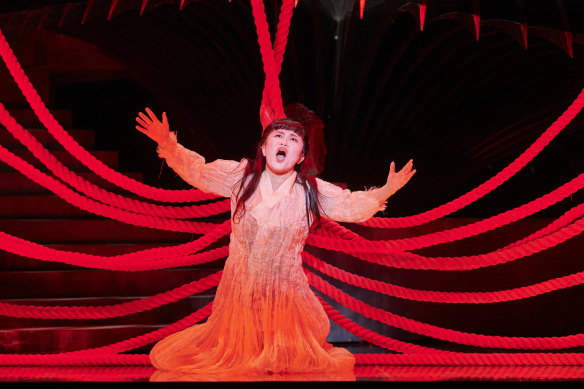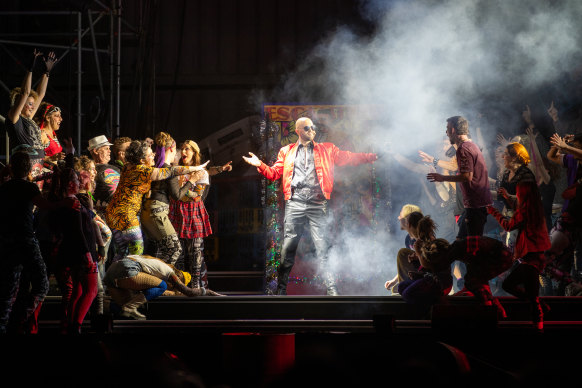This was published 2 years ago
Opera Australia executive payments increase by half amid turmoil
Opera Australia has paid out an extra $1 million to executives in a year that had a number of high-profile departures from the company in the wake of allegations of a toxic culture.
The extra payment pushed the company into a deficit of $447,878 for the financial year, show its latest financial statements, issued in conjunction with its annual report.

Sae-Kyung Rim as Cio-Cio-San in Opera Australia’s 2022 production of Madama Butterfly at the Sydney Opera House.Credit: Guy Davies
In 2020-21, “key management personnel compensation” cost the company $2,459,291, in line with the prior five years. But in 2021-22, it jumped to $3,598,251, a rise of more than 46 per cent.
When asked about the sudden and significant increase, Opera Australia’s chief executive Fiona Allan responded that “none of us are authorised to speak about that”.
The payment is listed as compensation “made to the 12 employees ... on the executive team for their contributions as employees for the Group and for conducting and directing services”.
Since the end of the past financial year, there has been a significant slimming down of the executive team, with only six of the 12 continuing in their roles (new artistic director Jo Davies is due to join in November, but is already working part-time to program the 2024 season).
One of the most significant departures was former artistic director Lyndon Terracini, who abruptly left his role of 13 years more than a year ahead of schedule.
Terracini, who was embroiled in a dispute with a cast member in early 2022, is not mentioned in Allan’s CEO’s message in the annual report, which this masthead has seen ahead of its release on Wednesday, although he is thanked by board chair Rod Sims.
Another significant departure from the executive team was technical director Clif Bothwell, who resigned in September 2022.
Asked whether the extra $1 million-plus was paid to one person, multiple people, or split evenly, and whether Terracini had received a departure payout, Opera Australia gave the following response: “Like many arts companies, OA experienced quite a bit of movement in personnel at all levels over the three years since pandemic hit, which was reflective of the uncertainty felt by many at the time. And this included our executive team.
“When any employee leaves OA, the Company is required to pay out all statutory annual and long service leave that has been accrued, which is represented by the figure you refer to in the annual report.
“OA does not provide details about any employees’ final salary payment, and therefore we cannot make comment relating to anyone specifically.”
Allan writes in the report that “we took important steps towards genuine cultural change”. Asked by this masthead to elaborate, she said that when she came into her role, she was surprised by the things OA didn’t already have in place, including acknowledgments of Country or systems of support. “We weren’t reflecting good contemporary practice, I would say.”
She described as “sobering” an employee survey in which one in three people in the company had reported a culture of bullying and harassment. The annual report claims measures have been taken to combat this, including training and a new hotline.

The character of Escamillo and the Opera Australia Chorus in Opera Australia’s 2022 production of Carmen on Cockatoo Island.Credit: Edwina Pickles
She said that “although there are still many things we need to address in the workplace”, the most significant shift was that in the most recent employee survey, bullying was no longer identified as an issue.
Overall, the company reported a loss of $447,878 in the financial year 2021-22. However, the previous year’s surplus of $39,602,308 was largely the result of the sale of a warehouse property, plus government COVID-19 support payments.
Though box-office figures were strong, key issues identified in the latest reports include increased costs, changes in booking patterns, and the winding down of COVID-19 support payments from the government.
“Our costs of production have gone up nearly 50 per cent in some areas since COVID,” says Allan. “I think audiences will return, I think our income will get back to what we want it to be – but our costs of making opera are increasing in a way that we can’t pass onto audiences.”
Allan points to musicals as one way of increasing income and widening the company’s audience base. “Opera never makes you money – that’s why we’re a subsidised company,” she says.
The annual report highlights that 50 per cent of opera tickets sold and 75 per cent of musicals tickets sold were to first-time buyers.
With costs unlikely to go down in the next year, Opera Australia is looking at ways to manage the coming challenges. “We want to grow our way out of this rather than cut our way out of this.”
The Booklist is a weekly newsletter for book lovers from books editor Jason Steger. Get it every Friday.